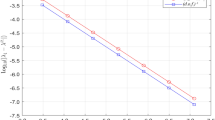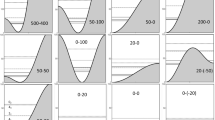Abstract
The polarizability operator plays a central role in density functional perturbation theory and other perturbative treatment of first principle electronic structure theories. The cost of computing the polarizability operator generally scales as \({\mathcal {O}}(N_{e}^4)\) where \(N_e\) is the number of electrons in the system. The recently developed adaptively compressed polarizability operator (ACP) formulation [L. Lin, Z. Xu and L. Ying, Multiscale Model. Simul. 2017] reduces such complexity to \({\mathcal {O}}(N_{e}^3)\) in the context of phonon calculations with a large basis set for the first time, and demonstrates its effectiveness for model problems. In this paper, we improve the performance of the ACP formulation by splitting the polarizability into a near singular component that is statically compressed, and a smooth component that is adaptively compressed. The new split representation maintains the \({\mathcal {O}}(N_e^3)\) complexity, and accelerates nearly all components of the ACP formulation, including Chebyshev interpolation of energy levels, iterative solution of Sternheimer equations, and convergence of the Dyson equations. For simulation of real materials, we discuss how to incorporate nonlocal pseudopotentials and finite temperature effects. We demonstrate the effectiveness of our method using one-dimensional model problem in insulating and metallic regimes, as well as its accuracy for real molecules and solids.








Similar content being viewed by others
References
Adler, S.L.: Quantum theory of the dielectric constant in real solids. Phys. Rev. 126, 413–420 (1962)
Anderson, D.G.: Iterative procedures for nonlinear integral equations. J. Assoc. Comput. Mach. 12, 547–560 (1965)
Baroni, S., Giannozzi, P., Testa, A.: Green’s-function approach to linear response in solids. Phys. Rev. Lett. 58, 1861–1864 (1987)
Baroni, S., de Gironcoli, S., Dal Corso, A., Giannozzi, P.: Phonons and related crystal properties from density-functional perturbation theory. Rev. Mod. Phys. 73, 515–562 (2001)
Becke, A.D.: Density-functional exchange-energy approximation with correct asymptotic behavior. Phys. Rev. A 38, 3098–3100 (1988)
Bowler, D.R., Miyazaki, T.: O(N) methods in electronic structure calculations. Rep. Prog. Phys. 75, 036503 (2012)
Cancès, E., Deleurence, A., Lewin, M.: A new approach to the modeling of local defects in crystals: the reduced Hartree-Fock case. Commun. Math. Phys. 281, 129–177 (2008)
Cancès, E., Deleurence, A., Lewin, M.: Non-perturbative embedding of local defects in crystalline materials. J. Phys.: Condens. Matter. 20, 294213–294218 (2008)
Cances, E., Mourad, N.: A mathematical perspective on density functional perturbation theory. Nonlinearity 27, 1999 (2014)
Ceperley, D.M., Alder, B.J.: Ground state of the electron gas by a stochastic method. Phys. Rev. Lett. 45, 566–569 (1980)
Chan, T.F., Hansen, P.C.: Computing truncated singular value decomposition least squares solutions by rank revealing QR-factorizations. SIAM J. Sci. Stat. Comput. 11, 519–530 (1990)
Cheng, H., Gimbutas, Z., Martinsson, P.G., Rokhlin, V.: On the compression of low rank matrices. SIAM J. Sci. Comput. 26, 1389–1404 (2005)
Foerster, D.: Elimination, in electronic structure calculations, of redundant orbital products. J. Chem. Phys. 128, 034108 (2008)
Frenkel, D., Smit, B.: Understanding Molecular Simulation: From Algorithms to Applications. Academic Press, New York (2002)
Giustino, F., Cohen, M.L., Louie, S.G.: GW method with the self-consistent Sternheimer equation. Phys. Rev. B 81, 115105 (2010)
Goedecker, S.: Linear scaling electronic structure methods. Rev. Mod. Phys. 71, 1085–1123 (1999)
Gonze, X., Lee, C.: Dynamical matrices, Born effective charges, dielectric permittivity tensors, and interatomic force constants from density-functional perturbation theory. Phys. Rev. B 55, 10355 (1997)
Gu, M., Eisenstat, S.: Efficient algorithms for computing a strong rank-revealing qr factorization. SIAM J. Sci. Comput. 17(4), 848–869 (1996)
Hohenberg, P., Kohn, W.: Inhomogeneous electron gas. Phys. Rev. 136, B864–B871 (1964)
Kleinman, L., Bylander, D.M.: Efficacious form for model pseudopotentials. Phys. Rev. Lett. 48, 1425–1428 (1982)
Knyazev, A.V.: Toward the optimal preconditioned eigensolver: locally optimal block preconditioned conjugate gradient method. SIAM J. Sci. Comp. 23, 517–541 (2001)
Kohn, W.: Density functional and density matrix method scaling linearly with the number of atoms. Phys. Rev. Lett. 76, 3168–3171 (1996)
Kohn, W., Sham, L.: Self-consistent equations including exchange and correlation effects. Phys. Rev. 140, A1133–A1138 (1965)
Lee, C., Yang, W., Parr, R.G.: Development of the Colle-Salvetti correlation-energy formula into a functional of the electron density. Phys. Rev. B 37, 785–789 (1988)
Lin, L., Lu, J., Ying, L.E.W.: Pole-based approximation of the Fermi-Dirac function. Chin. Ann. Math. 30B, 729 (2009)
Lin, L., Saad, Y., Yang, C.: Approximating spectral densities of large matrices. SIAM Rev. 58, 34 (2016)
Lin, L., Xu, Z., Ying, L.: Adaptively compressed polarizability operator for accelerating large scale ab initio phonon calculations. Multiscale Model. Simul. 15, 29–55 (2017)
Lu, J., Sogge, C.D., Steinerberger, S.: Approximating pointwise products of Laplacian eigenfunctions (2018). Preprint arXiv:1811.10447
Lu, J., Ying, L.: Compression of the electron repulsion integral tensor in tensor hypercontraction format with cubic scaling cost. J. Comput. Phys. 302, 329 (2015)
Martin, R.: Electronic Structure: Basic Theory and Practical Methods. Cambridge Univ. Pr, West Nyack, NY (2004)
Mermin, N.: Thermal properties of the inhomogeneous electron gas. Phys. Rev. 137, A1441 (1965)
Moussa, J.E.: Minimax rational approximation of the fermi-dirac distribution. J. Chem. Phys. 145(16), 164108 (2016)
Nakatsukasa, Y., Sète, O., Trefethen, L.N.: The aaa algorithm for rational approximation. SIAM J. Sci. Comput. 40(3), A1494–A1522 (2018)
Nguyen, H.V., Pham, T.A., Rocca, D., Galli, G.: Improving accuracy and efficiency of calculations of photoemission spectra within the many-body perturbation theory. Phys. Rev. B 85, 081101 (2012)
Niklasson, A.M.N., Challacombe, M.: Density matrix perturbation theory. Phys. Rev. Lett. 92, 193001 (2004)
Onida, G., Reining, L., Rubio, A.: Electronic excitations: density-functional versus many-body Greens-function approaches. Rev. Mod. Phys. 74, 601 (2002)
Paige, C.C., Saunders, M.A.: Solution of sparse indefinite systems of linear equations. SIAM J. Numer. Anal. 12, 617–629 (1975)
Perdew, J.P., Burke, K., Ernzerhof, M.: Generalized gradient approximation made simple. Phys. Rev. Lett. 77, 3865–3868 (1996)
Perdew, J.P., Zunger, A.: Self-interaction correction to density-functional approximations for many-electron systems. Phys. Rev. B 23, 5048–5079 (1981)
Ren, X., Rinke, P., Blum, V., Wieferink, J., Tkatchenko, A., Sanfilippo, A., Reuter, K., Scheffler, M.: Resolution-of-identity approach to Hartree-Fock, hybrid density functionals, RPA, MP2 and GW with numeric atom-centered orbital basis functions. New J. Phys. 14, 053020 (2012)
Sodt, A., Subotnik, J.E., Head-Gordon, M.: Linear scaling density fitting. J. Chem. Phys. 125, 194109 (2006)
Solovej, J.P.: Proof of the ionization conjecture in a reduced Hartree-Fock model. Invent. Math. 104, 291–311 (1991)
Umari, P., Stenuit, G., Baroni, S.: Optimal representation of the polarization propagator for large-scale GW calculations. Phys. Rev. B 79(20), 201104 (2009)
Umari, P., Stenuit, G., Baroni, S.: GW quasiparticle spectra from occupied states only. Phys. Rev. B 81, 115104 (2010)
Weigend, F.: A fully direct RI-HF algorithm: implementation, optimised auxiliary basis sets, demonstration of accuracy and efficiency. Phys. Chem. Chem. Phys. 4, 4285–4291 (2002)
Wiser, N.: Dielectric constant with local field effects included. Phys. Rev. 129, 62–69 (1963)
Woolfe, F., Liberty, E., Rokhlin, V., Tygert, M.: A fast randomized algorithm for the approximation of matrices. Appl. Comput. Harmon. Anal. 25(3), 335–366 (2008)
Yang, C., Meza, J.C., Lee, B., Wang, L.W.: KSSOLV-a MATLAB toolbox for solving the Kohn-Sham equations. ACM Trans. Math. Software 36, 10 (2009)
Acknowledgements
This work was partially supported by the National Science Foundation under Grant No. DMS-1652330 (D. A. and L. L.), the U.S. Department of Energy under Contract No. DE-SC0017867 (L. L. and Z. X.), and the U.S. Department of Energy under the Center for Applied Mathematics for Energy Research Applications (CAMERA) program (L. L.). We thank Berkeley Research Computing for the computational resources.
Author information
Authors and Affiliations
Corresponding author
Ethics declarations
Conflict of interest
The authors declare that they have no conflict of interest.
Additional information
Publisher's Note
Springer Nature remains neutral with regard to jurisdictional claims in published maps and institutional affiliations.
Appendix A
Appendix A
Using the Cauchy contour integral formulation, the density matrix at finite temperature can be represented as
When the Hamiltonian is perturbed to \( H_{\varepsilon } = H_{0} + \varepsilon \mathfrak {g}\), and when \(\varepsilon \) is small enough, the perturbed density matrix \(P_\varepsilon \) can still be computed as
Then we have
Hence by the definition of \(\mathfrak {X}_{0}\), we have
Using the spectral decomposition of H, and use the contour integral formulation
where the \(\frac{f_j - f_k}{\varepsilon _j - \varepsilon _k}\) is interpreted as the derivative when \(j=k\).
For the purpose of computing singular part with contour representation, we have
where \(H_{c,1}=\sum _{i=1}^{N_{\mathrm {cut}}} \psi _{i} \varepsilon _{i}\psi _{i}^{*}, H_{c,2}=\sum _{i=N_{\mathrm {cut}}+1}^{\widetilde{N}_{\mathrm {cut}}} \psi _{i} \varepsilon _{i}\psi _{i}^{*}\) are the Hamiltonian operators projected to the subspace spanned by the first \(N_{\mathrm {cut}}\) states, and to the subspace spanned by the following \((\widetilde{N}_{\mathrm {cut}} - N_{\mathrm {cut}})\) states, respectively.
Rights and permissions
About this article
Cite this article
An, D., Lin, L. & Xu, Z. Split representation of adaptively compressed polarizability operator. Res Math Sci 8, 51 (2021). https://doi.org/10.1007/s40687-021-00285-0
Received:
Accepted:
Published:
DOI: https://doi.org/10.1007/s40687-021-00285-0
Keywords
- Density functional perturbation theory
- Phonon calculations
- Vibration properties
- Adaptive compression
- Split representation
- Polarizability operator
- Sternheimer equation
- Dyson equation




